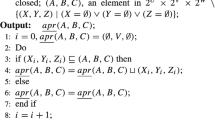Abstract
Approximation is an important issue in rough set theory. In this study, we consider approximation by the matroidal approach. First, we study three lattices induced by an information system. Two of the three lattices are selected as the macrostructure and microstructure for approximation, respectively. Second, based on the two lattices, we define double-matroid lattices, where the upper and lower approximations with respect to an information system are depicted. Since the two lattices are geometric, we actually present approximation by the matroidal approach. Finally, we study the connection between our double-matroid lattices and granular partition lattices. Specifically, the comparison of these two structures is presented in both micro-level and macro-level.













Similar content being viewed by others
Explore related subjects
Discover the latest articles, news and stories from top researchers in related subjects.Notes
For ease in working, we denote the partition \(\{1,2\},\{3,4\}\) by (12)(34), and the partition {1,2},{3},{4} simply by its non-trivial block (12).
References
Bisi C, Chiaselotti G, Ciucci D, Gentile T, Infusino FG (2017) Micro and macro models of granular computing induced by the indiscernibility relation. Inf Sci 388–389:247–273
Cattaneo G, Ciucci D (2009) Lattices with interior and closure operators and abstract approximation spaces. In: Peters JF et al (eds) Transactions on rough sets X, LNCS, vol 5656. Springer, Heidelberg, pp 67–116
Chen XY, Li QG (2007) Construction of rough approximations in fuzzy setting. Fuzzy Sets Syst 159:2641–2653
Chiaselotti G, Ciucci D, Gentile T, Infusino FG (2016) The granular partition lattice of an information table. Inf Sci 373:57–78
Dubois D, Prade H (1990) Rough fuzzy sets and fuzzy rough sets. Int J Gen Syst 17:191–209
Lee T (1987) An information-theoretic analysisof relational databases- part 1: data dependencies and metric. IEEE Trans Softw Eng SE-13 10:1049–1061
Li XN, Liu SY (2012) Matroidal approaches to rough sets via closure operators. Int J Approx Reason 53:513–527
Li XN, Yi HJ, Liu SY (2016) Rough sets and matroids from a lattice-theoretic viewpoint. Inf Sci 342:37–52
Li XN, Yi HJ, She YH, Sun BZ (2017a) Generalized three-way models based on subset-evaluation. Int J Approx Reason 83:142–159
Li XN, Sun BZ, She YH (2017b) Generalized matroids based on three-way decision models. Int J Approx Reason 90:192–207
Mao H (2014) Characterization and reduction of concept lattices through matroid theory. Inf Sci 281:338–354
Marek VW, Skowron A (2014) Rough sets and matroids. In: Peters JF, Skowron A (eds) Transactions on rough sets XVII, LNCS, vol 8375, pp 74–81
Oxley JG (1992) Matroid theory. Oxford University Press, New York
Pawlak Z (1982) Rough sets. Int J Comput Inf Sci 11:341–356
Pawlak Z (1991) Rough sets: theoretical aspects of reasoning about data, system theory, knowledge engineering and problem solving, vol 9. Kluwer Academic Publishers, Dordrecht
Skowron A (1996) Tolerance approximation spaces. Fundam Inform 27:245–253
Wang GY, Skowron A, Yao YY, Ślȩzak D, Polkowski L (eds) (2017) Thriving rough sets: 10th anniversary- Honoring professor Z. Pawlak’s life and legacy and 35 years of rough sets. Springer, Cham
Wang SP, Zhu QX, Zhu W, Min F (2012) Matroidal structure of rough sets and its characterization to attribute reduction. Knowl-Based Syst 36:155–161
Wang SP, Zhu QX, Zhu W, Min F (2014) Rough set characterization for 2-circuit matroid. Fundam Inform 129:377–393
Welsh D (1976) Matroid theory. Academic press, London
Yao YY (2004) A partition model of granular computing. In: Peters JF et al (eds) Transactions on rough sets I, LNCS, vol 3100, pp 232–253
Yao YY, Yao BX (2012) Covering based rough set approximations. Inf Sci 200:91–107
Zhu W, Wang SP (2013) Rough matroids based on relations. Inf Sci 232:241–252
Acknowledgements
The authors are grateful to Professor William Zhu for his help and the anonymous referees for their valuable suggestions. This work was supported by the National Natural Science Foundation of China (No. 61772019), the Shaanxi Province Natural Science Foundation Research Project (No. 2017JM1036), the Fundamental Research Funds for the Central Universities (No. JB170702) and the China Postdoctoral Science Foundation (No. 2016M602851).
Author information
Authors and Affiliations
Corresponding author
Ethics declarations
Conflict of interest
The authors declare that they have no conflict of interest.
Ethical approval
This article does not contain any studies with human participants or animals performed by any of the authors.
Additional information
Communicated by A. Di Nola.
Dedicated to Professor Sanyang Liu on the occasion of his 60th birthday.
Publisher's Note
Springer Nature remains neutral with regard to jurisdictional claims in published maps and institutional affiliations.
Rights and permissions
About this article
Cite this article
Li, X., Yi, H. & Wang, Z. Approximation via a double-matroid structure. Soft Comput 23, 7557–7568 (2019). https://doi.org/10.1007/s00500-018-03749-8
Published:
Issue Date:
DOI: https://doi.org/10.1007/s00500-018-03749-8





